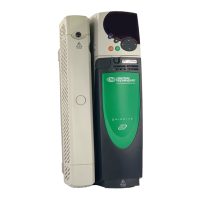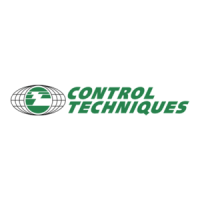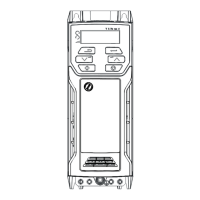Parameter
structure
Keypad and
display
Parameter
x.00
Parameter
description format
Advanced parameter
descriptions
Macros
Serial comms
protocol
Electronic
nameplate
Performance
Feature look-
up table
Menu 3
All modes
Unidrive SP Advanced User Guide 65
Issue Number: 7 www.controltechniques.com
system by the encoder is less, and so a higher control system bandwidth will be possible. So that the position values from the encoder can be used in
a position control system compensation is provided for the delay in obtaining the position before it is made available to Solutions Modules or in the
drive position parameters so that it appears to have been sampled at the datum. This compensation is based on the delay (i.e. 20µs or 150µs) and
the change of position over the previous sample.
EnDat comms
The following equations are used by the drive to determine the time taken to obtain the position information from an EnDat encoder. These are based
on t
cal
≤ 5µs, where t
cal
is the time from the first clock edge of the position command message from the drive to the first clock edge when the encoder
responds as defined in the EnDat specification. This limit of 5µs may exclude a small number of EnDat encoders from being used by the drive as a
comms only feedback device. It is also assumed that t
D
≤ 1.25µs where t
D
is the data delay from the encoder as defined by the EnDat specification for
105m of cable. Although with higher clock rates shorter cables must be used, and t
D
will be less than 1.25µs, the calculation performed by the drive
always assumes t
D
=1.25µs. It should be noted that all values are rounded up to the nearest microsecond.
Command message time = t
command
= 10T or t
cal
whichever is the longest
Where: T = 1/Baud Rate, t
cal
= 5µs
Time for single turn position = t
command
+ t
D
+ (2 + Single turn resolution) x T
= t
command
+ t
D
+ (2 + Pr 3.35) x T
Where: t
D
= 1.25µs
Time for whole message including CRC = Time for single turn position + (Number of turns bits + 5) x T
= Time for single turn position + (Pr 3.33 + 5) x T
For example an encoder with 12 turns bits, 13 bit single turn resolution and a baud rate of 2M would give the following times:
Time for single turn position = 14µs (13.75µs rounded up)
Time for the whole message including CRC = 23µs (22.25µs rounded up)
A recovery time (tm) is specified for EnDat encoders, that is the time required between the end of one data transfer and the beginning of the next one.
If this time is not allowed between messages that transfer the position from the encoder, the encoder operates in continuous mode and the data from
the encoder will be incorrect and cause CRC errors. tm is nominally 20µs, but may vary from 10µs to 30µs (EnDat 2.1 specification). If tm is greater
than 23µs and 6 or 12kHz switching is used, which have a fast sample rate of 83µs, it is possible for the time allowed for tm to be too short. Therefore
if 6 or 12kHz switching are used the total message transfer time should not exceed 53µs unless tm can be guaranteed to be less than 30µs by a
suitable margin.
SSI comms
The whole position must be obtained from an SSI encoder before it can be used by the drive, therefore the time for the single turn position and the
time for the whole message are the same.
Time to obtain the position= (Number of turns bits + Single turn resolution + 1) x T
= t
D
+ (Pr 3.33 + Pr 3.35 + 1) x T
For example an encoder with 12 turns bits, 13 bit single turn resolution and a baud rate of 1M would give the following time:
Time to obtain the position data = 28µs (27.25µs rounded up)
The drive does not include the recovery time of the encoder in these calculations, therefore the user must ensure that there is sufficient time after the
data transfer before the next transfer begins. If the encoder does not recover in time its output will be low just before the new transfer beings and will
cause an Enc5 trip.
The following encoders can be connected to the drive encoder port.
0, Ab: Quadrature incremental encoder, with or without marker pulse
1, Fd: Incremental encoder with frequency and direction outputs, with or without marker pulse
2, Fr: Incremental encoder with forward and reverse outputs, with or without marker pulse
This type of encoder can be used for motor control in closed-loop vector mode or servo mode. In servo mode a phasing test must be performed after
every drive power-up or encoder trip.
3, Ab.Servo: Quadrature incremental encoder with commutation outputs, with or without marker pulse
4, Fd.Servo: Incremental encoder with frequency, direction and commutation outputs, with or without marker pulse
5, Fr.Servo: Incremental encoder with forward, reverse and commutation outputs, with or without marker pulse
This type of encoder is normally only used in servo mode. If it is used in closed-loop vector mode the UVW signals are ignored. The UVW
commutation signals are used to define the motor position during the first 120deg electrical rotation after the drive is powered-up or the encoder
is initialised
3.38
Drive encoder type
Drive modes Open-loop, Closed-loop vector, Servo
Coding
Bit SP FI DE Txt VM DP ND RA NC NV PT US RW BU PS
1 111
Range Open-loop, Closed-loop vector, Servo 0 to 11
Default
Open-loop, Closed-loop vector
Servo
0
3
Update rate Background read (Only has any effect when the drive is disabled)
http://nicontrols.com

